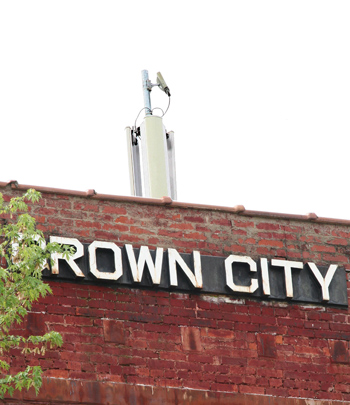Throughout much of its nearly 200-year history, Crown City, Ohio, has been known as a way station for travelers on the Ohio River. The shipping artery brought boats, people, supplies and, on occasion, devastating floods to this small southeastern Ohio community.

Today, a tall antenna standing on a West Virginia ridge across the Ohio River provides the modern-day equivalent to the 19th-century waterway – wireless broadband Internet. Thanks to the Connecting Rural Ohio Wireless Neighborhood Project, a collaboration to bring Internet connectivity to Appalachian communities, the antenna disperses the invisible, wireless Internet signals into Crown City homes and businesses.
A community learning center in the Village Hall enables access for residents without a wireless modem or a home computer. With six new computers, a printer and a wireless network, the center brings online educational opportunities and e-commerce possibilities to residents who had previously been limited to slow dial-up Internet connections.
Crown City is the most recent beneficiary of the technology altruism of the CRO project, which unites partners like Ohio State’s Office of the CIO, the Ohio Supercomputer Center and the Governor’s Office of Appalachia, in improving the region’s broadband access.
The first community was New Straitsville, a village with fewer than 800 residents in southern Perry County, which received its wireless network in 2003. Next, Chesterhill, an enclave of 300 in Morgan County, was brought online in 2006, and last year, the project brought connectivity to Vinton, a village of just over 300 residents in northern Gallia County.
Each community involved in the project has been unique. The rolling terrain and thick forestry in the communities makes it tricky to engineer wide coverage of the wireless Internet signal. While the first three towns received their wireless connection by way of satellite, Crown City gets its connectivity through ConnectLink, Inc., a terrestrial wireless broadband vendor operating in southeastern Ohio, West Virginia and Kentucky.
The broadband signal shoots from the West Virginia tower to a dish affixed to a cell phone tower that sits on a hill above Crown City. The signal then travels down to another receiver sitting atop the two-story Village Hall. From there, three antennae transmit the wireless signal to the village residents, while a set of wires drop down into the learning center below to deliver connectivity.
Grants from groups such as the Ohio Governor’s Office of Appalachia, American Distance Education Consortium, Microsoft and the U.S. Department of Agriculture provided all the hardware and software installed at the various locations. Staff members of the Ohio State University’s Office of the CIO and the Ohio Supercomputer Center donate all the labor and time it takes to install that equipment. Taken together, the average installation is worth an estimated $30,000, and, upon completion of the installation process, the equipment becomes the property of the town.
Because the project’s supporters are interested not just in providing the equipment but also in opening up educational and commercial resources, they hold community meetings, recruit community partners to provide follow-up education and establish technical-support networks. Education organizations such as Rio Grande Community College/University of Rio Grande, the Ohio Learning Network, the OSU Extension office and Mindleaders provide online training courses for community members.
These communities — and many others in Ohio’s 29 Appalachian counties — have not fared equally in today’s fast-paced, technology-driven world. Employment and education opportunities are limited, and in most of these hilly and out-of-the-way villages, there is very limited Internet connectivity or none at all.
The CRO project aims to provide access to Web-based training and education, stabilize and stimulate the local economy and increase the community’s standard of living. Since the completion of the projects in New Straitsville and Chesterhill, the commercial sector has recognized the demand for broadband and has installed DSL connectivity to those communities. The CRO team, in such cases, is pleased to have served those communities until private vendors could offer additional services.
For more information about Connecting Rural Ohio and its partners, go to http://cro.osc.edu .